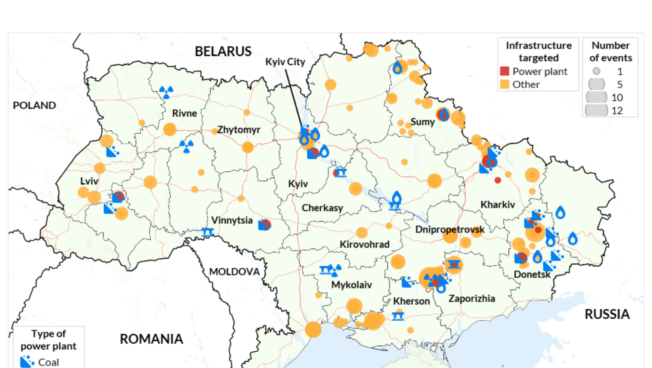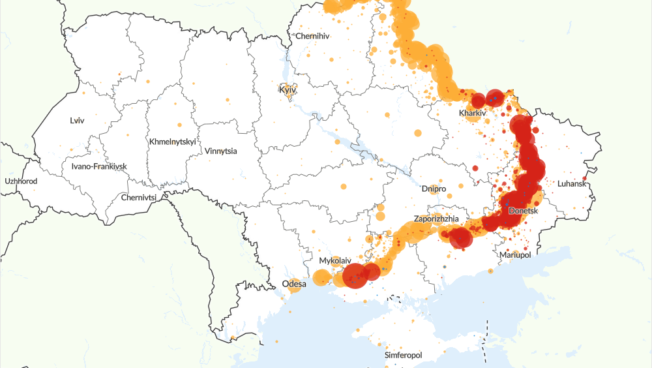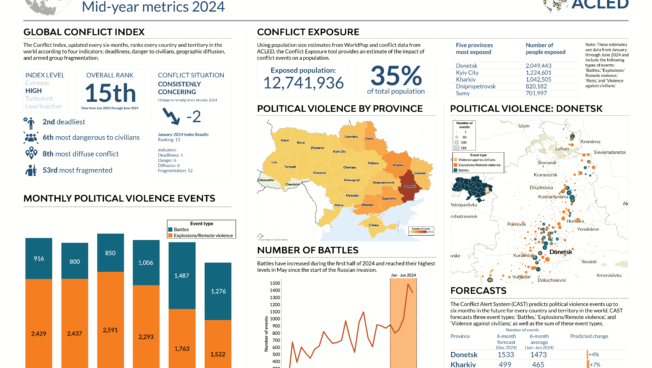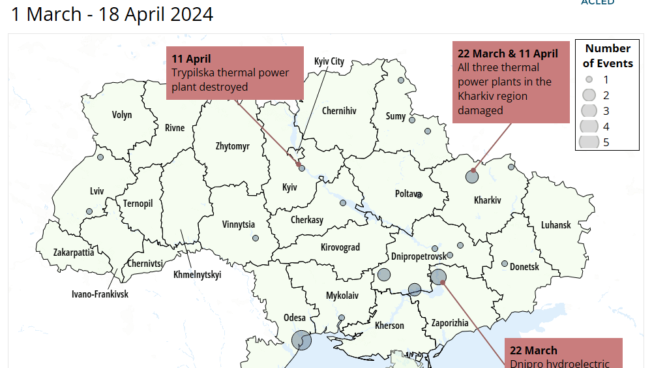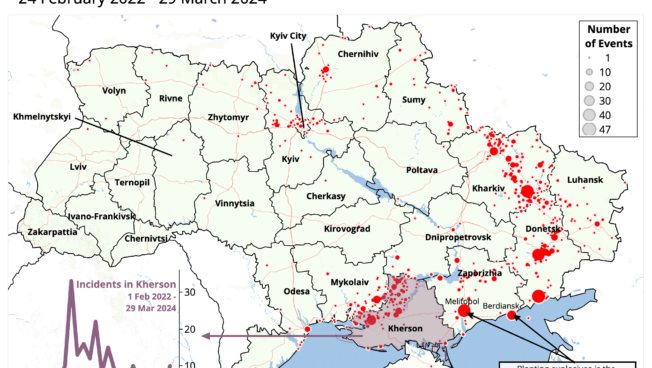Last updated: 9 July 2025
Amid the ongoing war in Ukraine, this aerial photograph shows the destruction in the village of Bohorodychne in the Donetsk region on 27 January 2024. Photo by Roman Pilipey/AFP via Getty Images
ACLED’s Ukraine Conflict Monitor provides near real-time information on the ongoing war, including an interactive map of the latest data from the start of Russia’s invasion, a curated data file, and weekly situation updates. It is designed to help researchers, policymakers, media, and the wider public track key conflict developments in Ukraine. It is released every Wednesday, with data covering events from Saturday to Friday of the preceding week and providing updates to past events as new or better information becomes available.
Ukraine war situation update
28 June – 4 July 2025
Key trends
- In the Donetsk region, Russian forces seized six settlements — three along the boundary with the Dnipropetrovsk region, two northeast of Pokrovsk, and one east of Kostiantynivka.
- Russian forces captured two villages close to the Russian border east and northeast of Velykyi Burluk in the Kharkiv region and another village near the international border in the Sumy region.
- ACLED records at least 35 Russian long-range missile and drone strikes, including in the western regions of Ivano-Frankivsk, Khmelnytskyi, Lviv, and Ternopil.
- Russian shelling, missiles, aerial bombs, and drones killed at least 42 civilians in the Dnipropetrovsk, Donetsk, Kharkiv, Kherson, Mykolaiv, Odesa, and Zaporizhia regions, as well as in the city of Kyiv. Meanwhile, Ukrainian shelling, drones, and missiles reportedly killed at least eight civilians in the occupied parts of the Donetsk, Luhansk, and Kherson regions.
Key events
- 1 Jul. | Dnipropetrovsk – Russian missiles kill three commanding officers of a Ukrainian brigade and an unspecified number of soldiers in Huliaipole
- 3 Jul. | Poltava – Russian drones hit a military recruitment center in Poltava city, killing two people and wounding 59
- 3 Jul. | Luhansk – Explosives planted by Ukraine’s security service kill a former pro-Russian mayor of Luhansk city
Spotlight: A record-high barrage of drones and missiles hits Ukraine
Overnight on 3 and 4 July, Russian forces launched 539 drones, including decoy drones, and 11 missiles at Ukraine, breaking another record in the number of drones launched during a single coordinated attack since the start of the full-scale invasion.1Victoria Butenko, et al., “Russia launches record number of drones at Ukraine after latest Trump-Putin phone call,” CNN, 4 July 2025 Ukrainian forces intercepted 478 of the projectiles.2Anett Abramova, “Russia launched over 500 UAVs and a dozen missiles into Ukraine. The Air Force spoke about another massive attack,” Hromadske, 4 July 2025 (Ukrainian) The attack came shortly after yet another call between United States President Donald Trump and Russian President Vladimir Putin.3Paul Sonne and Tyler Pager, “Trump Says Call With Putin Yields No Progress on Ukraine Cease-Fire,” The New York Times, 3 July 2025 It mainly focused on the capital city of Kyiv, where it lasted around 13 hours,4Vitalii Chervonenko and Mariana Matviichuk, “Massive Russian strike on Kyiv: three people killed, dozens injured,” BBC, 4 July 2025 (Ukrainian) killing three civilians and wounding over 30 others. The attack damaged infrastructure in at least five of Kyiv’s 10 boroughs, including apartment buildings, railway infrastructure, schools, a medical facility, and the Embassy of Poland in Kyiv’s historical city center.
The attack came only several days after the previous record-breaking wave of Russian drones and missiles. On 29 June, Russia launched 477 drones and 60 missiles at Ukraine, 475 of which were intercepted.5Nataliia Yurchenko, “Russians fired a record 537 targets at Ukraine: how many missiles and drones did air defense shoot down,” RBC-Ukraine, 29 June 2025 (Ukrainian) The attack and fallen debris struck over a dozen locations across the central and western regions of Ukraine, injuring civilians and damaging residential buildings, educational facilities, a hospital, and other civilian infrastructure. The number of drones Russia has launched against Ukraine has been on the rise this year. Russia launched over 5,000 drones in June — twice that of the highest recorded number in 2023.6Yuliia Taradiuk, “Smashing previous monthly record, Russia launches 5,337 kamikaze drones against Ukraine during June,” The Kyiv Independent, 30 June 2025
Explore the ACLED Conflict Exposure tool to assess the numbers of people affected by armed violence, disaggregated by locations, time period, and actors involved.
Ukraine Conflict: Interactive Map
This interactive map includes political violence events in Ukraine since the start of the Russian invasion on 24 February 2022.
Date and subset filters
By default, the map displays data for the most recent week. Use the date filters to change the date range in view.
Use the subset filters to analyze trends in more detail.
Changing view
By default, the map is set to event view, which uses scaled circles to show events at a given location. Click on a region in Ukraine to zoom in for a more detailed view. Hovering over a region will give a count of events within its borders.
Changing to region (oblast) view will switch the map to a choropleth, giving an overview of event density per region. This will also disable the zoom function.
Events in Russia
While in event view, use the ‘Events in Russia’ toggle to show or hide conflict-related events in Russia. Conflict-related events are identified as follows:
- All events with the ‘Battles’ or ‘Explosions/remote violence’ event type.
- Events with the ‘Violence against civilians’ event type, where the actor is:
- Ukrainian or Russian military
- Russian border guards
- Pro-Ukrainian Russian militias
Attacks on Ukranian infrastructure
ACLED uses four automatically generated infrastructure tags when coding events that occur in Ukraine, each covering a vital sector that focuses on civilian infrastructure: energy, health, education, and residential infrastructure.
For more information, read our methodology explainer.
Event counts and civilian fatalities
The box in the bottom right hand corner displays event counts in total, disaggregated by event type, and filtered by date or subset according to the options already selected.
It also shows a conservative estimate of civilian fatalities, limited to events where civilians are targeted directly. Military casualties are not represented on the map as they are largely unverifiable.
For more information on how ACLED codes fatalities, read our methodology explainer.
Curated Data
This file contains all political violence events, demonstration events, and strategic developments recorded in Ukraine and the Black Sea from the beginning of ACLED coverage in 2018 to the present.
For an overview, see our interactive dashboard.
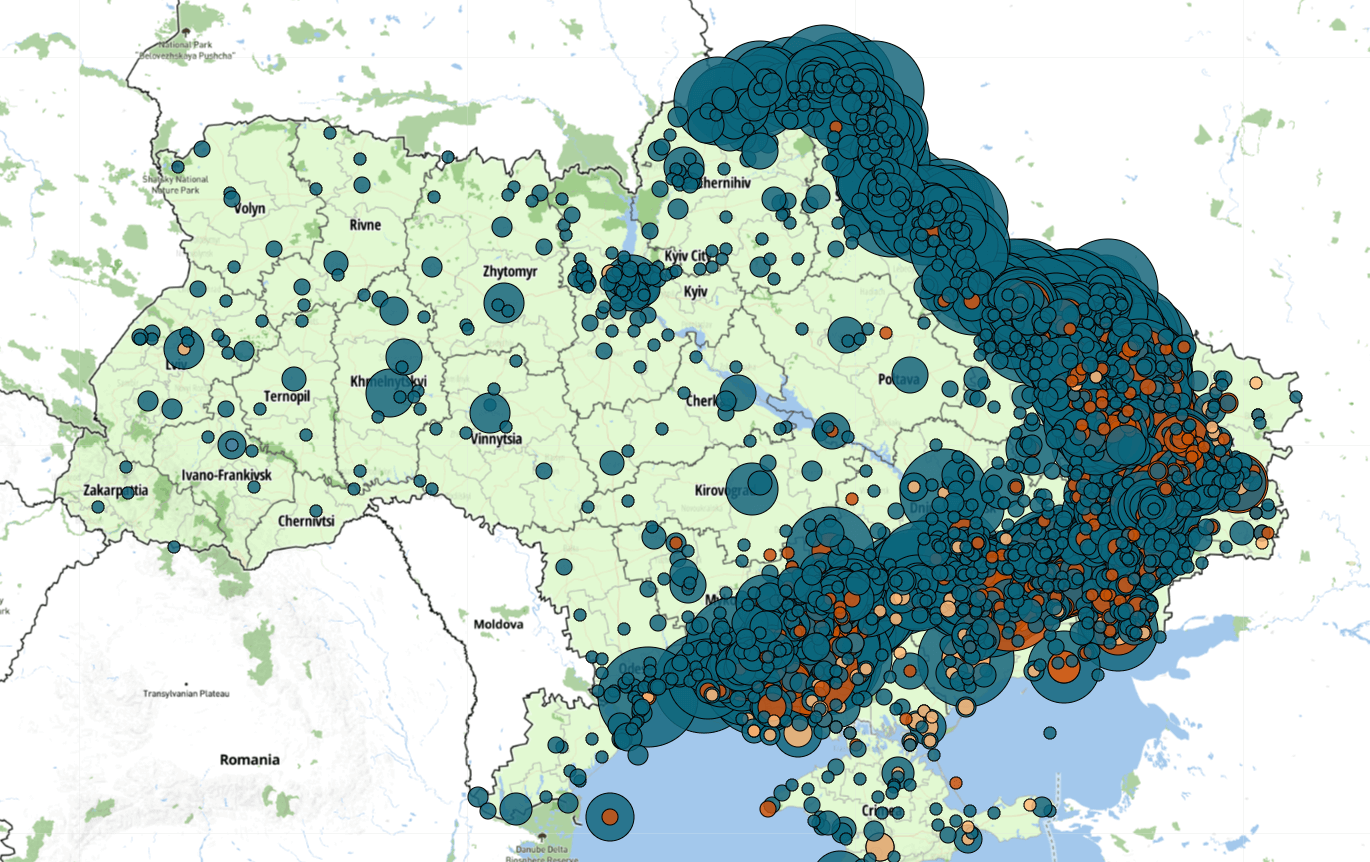
Ukraine & the Black Sea ( 13 June 2025 )
Attacks on Ukranian infrastructure
ACLED uses four automatically generated infrastructure tags when coding events that occur in Ukraine, each covering a vital sector that focuses on civilian infrastructure: energy, health, education, and residential infrastructure. This file contains all events featuring one or more of these tags.
For more information, read our methodology note.
Sign up for Ukraine Conflict Monitor updates
Information & Analysis
For additional information on the conflict in Ukraine, check our analysis of political violence trends from the start of ACLED coverage in 2018.

